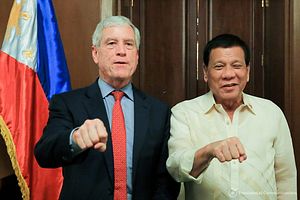On Tuesday morning, Australian Defense Minister Marise Payne announced some details about Canberra’s growing military assistance to the Philippines following a meeting with her counterpart, Delfin Lorenzana. Though Payne’s announcement was not unexpected in the broader context of the longstanding Australia-Philippines defense relationship, it nonetheless shed more light on the shape of Canberra’s newly stepped up counterterrorism role in Manila amid the continued Islamic State threat in the region.
As I have noted before, Australia and the Philippines have long had a strong relationship that extends into the defense realm, with security ties including not just regular interactions like exchanges and exercises but capacity-building in areas ranging from maritime security to counterterrorism, as well as assistance with respect to the peace process in the southern Philippines (See: “New Australia Military Terror Aid for the Philippines?”).
Though the emergence of President Rodrigo Duterte has no doubt complicated things somewhat, the Marawi crisis has reinforced the importance of the bilateral defense relationship, with Australia offering various forms of support including AP-3C Orion military planes to help with surveillance. Over the past few months, Australian officials have been signaling that Canberra may look to further boost its direct military assistance to the Philippines, including some sort of “advising, assisting, and training” role (See: “What Will Australia’s New Terror Aid to the Philippines Look Like?”).
On October 24, Payne, who was in the Philippines to attend the ASEAN Defense Ministers Meeting-Plus (ADMM-Plus), met with Lorenzana. Though the agenda for the meeting was more wide-ranging and there had been several significant developments of late including the so-called “liberation” of Marawi, the shape of Canberra’s counterterrorism assistance to Manila was a subject of focus both in their deliberations as well as in their public remarks as the battle against the wider terrorism threat continues (See: “ASEAN’s Post-Marawi Islamic State Challenge”).
In the realm of training, Payne said up to 80 Australian Army personnel will work on Philippine bases to provide expert training to the Philippine Army and Marine Corps. The mobile training teams would provide training in various areas of counterterrorism, including urban warfare.
Beyond this, she also said that Australia would provide more intelligence, surveillance, and reconnaissance (ISR) support, including increasing intelligence sharing and carrying out maritime patrols, and that the two countries would host a seminar on post-conflict rehabilitation efforts as well. Lorenzana added that the two countries would also be looking for additional opportunities to boost their defense cooperation, such as more visits and exchanges involving Philippine military personnel and information sharing.
Payne also visited the crew of a AP-3C Orion plane and other Australian military personnel that have helped support Philippine ground units in Marawi. Though the planes remain the most visible support Australia provides to the Philippines and will likely continue to dominate news about its assistance, Payne’s announcements and the actual shape of Canberra’s counterterrorism aid are a useful reminder that there continues to be a deliberate attempt to make sure it is in fact more multi-faceted.

































